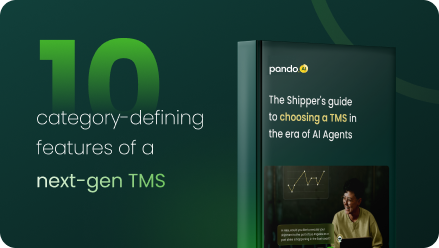Second Largest Tape and Film Product Manufacturer in the US Cuts Freight Costs by 4% with AI
How manual spreadsheets and scattered systems gave way to Pando's AI-powered solution, transforming logistics across 30+ global locations for this packaging giant.

4 %
direct reduction in total freight spend
80 %
boost in team operational productivity
100 %
unified visibility across all shipments
AI that changed how we do logistics
We were basically running a company with $10B+ in revenue like a small business - everything was spreadsheets, phone calls, and manual processes. The amount of time we spent just chasing information was ridiculous. Now we have complete control over our freight operations with Pando's AI-first solutions.
Head of Logistics
Top Packaging Company
Challenge vs Outcome
Business challenges
- Team juggling multiple carrier portals for basic shipment updates.
- Freight procurement decisions made without proper market intelligence.
- Manual invoice matching leading to payment delays and errors.
- No single source of truth for rates across modes.
- Spreadsheet-based processes breaking down under global complexity.
Business outcomes
- One platform handling all freight management across all modes.
- Data-driven procurement with real carrier performance insights.
- Automated invoice processing with built-in error detection.
- Centralized rate management with instant access for all teams.
- Streamlined workflows supporting complex global operations efficiently.
This packaging manufacturer with $10B+ in annual revenue operates across the world but with primary operations in North America, managing a $4M+ annual freight spend. Their supply chain includes numerous manufacturing facilities, a distribution network reaching a broad customer base, and established carrier relationships across 30+ global locations. They cater to businesses of all sizes requiring packaging and protective materials, offering a range of 1000 SKUs to meet diverse needs.
Industry
Packaging
Region
Global
Solutions used:
- AI freight procurement analyst
- AI transportation expert
- AI freight audit & pay specialist
When your incumbent TMS can't handle global complexity
The company's existing transportation management system, Uber Freight, worked fine for domestic shipments, but completely fell apart when handling international freight. Uber Freight simply couldn't manage the complexity of ocean imports, customs documentation, and multi-leg international movements. This forced the logistics team to cobble together a patchwork of manual processes and external tools just to get basic visibility into their global shipments.
Procurement was particularly painful. Every freight bidding event required building Excel spreadsheets from scratch, manually collecting quotes from dozens of carriers, and trying to compare rates across different service levels without any historical context. The team had no way to benchmark market rates or understand which carriers consistently delivered on their promises. Post-bid analysis was virtually impossible because all the data lived in disconnected spreadsheets.
The freight audit process was outsourced to a third-party provider, but this created more problems than it solved. Invoices arrived in dozens of different formats, carrier billing errors went undetected for weeks, and the company had no real-time visibility into their freight accruals. Finance teams were constantly surprised by unexpected charges that should have been caught earlier.
Perhaps most frustrating was the daily operational reality: logistics coordinators spent hours each day logging into different carrier websites just to check container status. Important documents got lost in email chains. Customs delays weren't communicated properly between teams. What should have been straightforward logistics operations felt unnecessarily complicated.
Every morning started with the same routine - log into ten different carrier portals, download Excel files, try to piece together what was actually happening with our shipments. It was the 2020's and we were still operating like it was 1990's
- Logistics Manager
How Pando’s AI-driven freight solution delivered 4% freight cost savings
Centralizing all freight data in one platform
The new system consolidated information from carriers, freight forwarders, and internal systems into a single dashboard. Instead of logging into multiple portals, the team now sees all shipments, rates, and performance metrics in one place. This unified view revealed cost-saving opportunities that were previously hidden across disconnected systems, while eliminating the daily time waste of manual data gathering.
Implementing intelligent freight procurement with market insights
The AI-powered procurement module transformed how the company approaches freight bidding. The system automatically benchmarks quoted rates against market data, flags unusually high or low bids, and provides carrier performance scorecards based on actual delivery history. Scenario planning tools let procurement teams model different service level trade-offs before making decisions, resulting in more strategic carrier selections.
For the first time, we're making procurement decisions based on real data instead of gut feelings. The system shows us which carriers actually deliver on time, not just who talks a good game in the sales meeting.
— Global Procurement Director
Automating freight audit with four-way matching
The manual invoice review process was replaced with automated matching that compares contracted rates, actual shipment details, carrier invoices, and purchase orders. The system automatically approves invoices that match within preset tolerances and flags discrepancies for manual review. This eliminated the week-long delays in freight payments while catching billing errors that previously slipped through manual audits.
Streamlining international shipment execution and visibility
Rather than juggling multiple carrier portals, the team now manages all shipments through integrated workflows that automatically trigger required actions. The system handles customs documentation, tracks container movements in real-time, and sends proactive alerts when shipments need attention. This eliminated the constant manual checking that consumed hours of coordinator time daily.
Creating unified rate management across all modes
All contracted rates, accessorial charges, and service terms now live in a centralized rate engine that's accessible to procurement, operations, and finance teams. Rate comparisons that previously required building complex spreadsheets can now be done instantly. The system automatically applies the correct rates during shipment execution, eliminating pricing errors and disputes.
Before, getting a simple rate comparison meant spending half a day building spreadsheets. Now I can answer pricing questions in real-time while I'm on the phone with customers. It's completely changed how responsive we can be.
— Logistics Manager
Enabling data-driven carrier performance management
The platform tracks detailed performance metrics for every carrier across on-time delivery, documentation accuracy, and cost competitiveness. This data feeds directly into future procurement decisions, ensuring the company rewards carriers who actually perform well rather than just those with the lowest quoted rates. Performance dashboards help identify trends before they impact customer service.
Digitalizing document management and collaboration
Shipping documents are now stored, shared, and tracked digitally within the platform. Customs paperwork gets automatically generated and shared with relevant parties. Version control issues disappeared because everyone works from the same centralized documents. This eliminated the email chains and document hunting that previously created delays in international shipments.
The transformation from manual, spreadsheet-driven logistics to Pando's integrated AI-powered platform delivered immediate and measurable results. The 4% reduction in freight costs, combined with the 80% improvement in operational productivity, has fundamentally changed how this packaging manufacturer approaches logistics management.
More importantly, the logistics team now spends their time on strategic activities rather than administrative busy work. They can respond to customer inquiries instantly, make procurement decisions based on real data, and proactively manage exceptions before they impact service. What was once a reactive, crisis-driven operation has become a competitive advantage for the business.
















